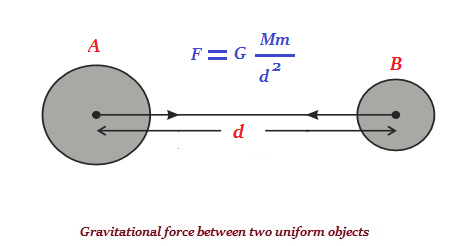Gravitation
Gravitation
Earth attracts all things towards it through an unseen force of attraction. This force of attraction is called as gravitation or gravitational pull.
You must have noticed that every time you throw an object upwards, it reaches a certain height and then falls down on the earth’s surface. So, we can conclude that these objects move under the gravitational forces or gravitational pull of the Earth which is nothing but a force of attraction.
Gravitational force or gravity of earth is the reason why you remain on earth and it pulls you down.
Universal Law of Gravitation.
Every object in the universe attracts every other object with a force which is proportional to the product of their masses and inversely proportional to the square of the distance between them. The force is along the line
joining the centers of two objects
.
According to the universal law of gravitation, the force between two objects is directly proportional to the product
of their masses.
That is,F= M × m
And the force between two objects is inversely proportional to the square of the distance between them, that is,
F∝1/d2
Combining Eqs. we get
F∝Mm/d2
or F=G × Mm/d2
Where G is the constant of proportionality and is called the universal gravitation constant.
From this we get
G=Fd2 /Mm
SI unit of G is Nm2 kg–2
Value of G was found out by Henry Cavendish (1731 – 1810) by using a sensitive balance as 6.673 × 10–11 Nm2 kg–2
Acceleration due to Gravitation(g)
Whenever an object falls towards the earth, an acceleration is involved. This acceleration is due to the earth’s gravitational force. Therefore, this acceleration is called the acceleration due to the gravitational force of the earth (or acceleration due to gravity). It is denoted by g. The unit of g is the same as that of acceleration, that is, m s–2
We know force is the product of mass and acceleration.
The magnitude of the gravitational force F will be equal to the product of mass and acceleration due to the gravitational force, that is,
F = m g ,substituting this in the above equation (F=G × Mm/d2)
g=G×M/d2
Value of g
To calculate the value of g, we should put the values of G, M and R in the above equation
Universal gravitational constant,
G =6.673 × 10–11 Nm2 kg–2
mass of the earth,
M = 6 × 1024 kg
and radius of the earth,
R = 6.4 × 106 m
and we get g=9.8 ms-2
Importance of the Universal Law of Gravitation
The universal law of gravitation successfully explained several phenomena which were believed to be unconnected:
(i) the force that binds us to the earth.
(ii) the motion of the moon around the earth.
(iii) the motion of planets around the Sun.
(iv) the tides due to the moon and the Sun.
Mass
Mass of an object is a measure of its inertia. Its SI unit is kilogram (kg).
Greater the mass of an object, the greater is the inertia. It remains the same whether the object is on
the earth, the moon or even in outer space. Thus, the mass of an object is constant and does not change from place to place.
Weight
The weight of an object is the force with which it is attracted towards the earth.
F = m × g
The force of attraction of the earth on an object is known as the weight of the object. It is denoted by W
W = m × g
SI unit is Newton
The weight is a force acting vertically downwards; it has both magnitude and direction.
The value of g is constant at a given place. Therefore at a given place, the weight of an object is directly
proportional to the mass, say m, of the object, that is,
W∝ m.
Because of to this reason that at a given place, we can use the weight of an object as a measure of its mass. The mass of an object remains the same everywhere, that is, on the earth and on any planet whereas its weight depends on its location.
Weight of an object on the Moon
The weight of an object on the moon is the force with which the moon attracts that object. The mass of the moon is less than that of the earth. Due to this the moon exerts lesser force of attraction on objects.
Weight of the object on the moon= (1/6) × its weight on the earth.
Thrust and Pressure
We know weight is the force acting vertically downwards.The force is acting perpendicular to the surface of the
sand.
The force acting on an object perpendicular to the surface is called thrust. i.e net force in a particular direction
(thrust) on the object concerned.
The thrust on unit area is called pressure. Thus,
thrust=Pressure/area
Archimedes’ Principle
When a body is immersed fully or partially in a fluid, it experiences an upward force that is equal to the weight of the fluid displaced by it.
Archimedes’ principle has many applications. It is used in designing ships andmsubmarines. Lactometers, which are used to determine the purity of a sample of milk and hydrometers used for determining density of liquids, are based on this principle.
Relative Density
the density of a substance is defined as mass of a unit volume.
The unit of density is kilogram per meter cube (kg m–3). The density of a given substance, under specified conditions, remains the same.
For example, the density of gold is 19300 kg m-3 while that of water is 1000 kg m-3. The density of a given
sample of a substance can help us to determine its purity.
It is often convenient to express density of a substance in comparison with that of water. The relative density of a substance is the ratio of its density to that of water:
Relative density=Density of a substance/Density of water
